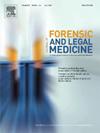猝死与原发性小脑膜黑素细胞增多症相关,无神经皮肤黑素病综合征特征
IF 1.2
4区 医学
Q3 MEDICINE, LEGAL
引用次数: 0
摘要
背景:小脑膜黑素细胞增多症是一种罕见的良性中枢神经系统黑素细胞增生,通常与神经性皮肤黑素病有关。没有皮肤受累的孤立形式是极其罕见的,特别是在成人中,并提出了重大的诊断和医学法律挑战。病例报告我们报告一名29岁男子猝死,无已知病史,发现俯卧位无反应。外检无外伤,毒理学阴性。肉眼和显微镜检查显示,前额颞顶叶皮层和小脑可见弥漫性轻脑膜黑素细胞浸润。组织学上,病变由含有细小黑色素的淡色黑色素细胞组成,无有丝分裂活性或异型性。在身体其他部位未发现原发性或转移性黑色素瘤。结果与原发性弥漫性小脑膜黑素细胞增多症一致。尽管在组织学上是良性的,但小脑膜黑素细胞增多症可能影响关键的中枢神经系统区域,可能导致癫痫发作、自主神经失调或猝死。本病例强调了对不明原因死亡进行彻底神经病理学调查的重要性。黑素细胞浸润的位置和范围提示可能与癫痫有关的终末期事件,突出了法医实践中罕见但重要的鉴别诊断。结论本病例强调了孤立原发性小脑膜黑素细胞增多症作为猝死的潜在原因的法医学意义。早期识别这种罕见的实体需要结合详细的尸检,组织病理学,并意识到其多变的临床表现,特别是在没有皮肤征象的情况下。这些发现对法医病理学家调查突然的、无法解释的死亡特别重要。本文章由计算机程序翻译,如有差异,请以英文原文为准。
Sudden death associated with primary leptomeningeal melanocytosis without features of neurocutaneous melanosis syndrome
Background
Leptomeningeal melanocytosis is a rare, benign melanocytic proliferation of the central nervous system, typically associated with neurocutaneous melanosis. Isolated forms without cutaneous involvement are extremely uncommon, especially in adults, and pose significant diagnostic and medicolegal challenges.
Case report
We report the sudden death of a 29-year-old man with no known medical history, found unresponsive in a prone position. External examination revealed no traumatic injuries, and toxicology was negative. Gross and microscopic examination of the brain demonstrated diffuse leptomeningeal melanocytic infiltration over the frontotemporoparietal cortex and cerebellum. Histologically, the lesion was composed of bland melanocytes containing fine melanin pigment without mitotic activity or atypia. No primary or metastatic melanoma was identified elsewhere in the body. The findings were consistent with primary diffuse leptomeningeal melanocytosis.
Discussion
Although histologically benign, leptomeningeal melanocytosis may affect critical CNS regions, potentially leading to seizures, autonomic dysregulation, or sudden death. This case emphasizes the importance of thorough neuropathological investigation in unexplained deaths. The location and extent of melanocytic infiltration suggest a possible seizure-related terminal event, highlighting a rare but important differential diagnosis in forensic practice.
Conclusion
This case underscores the forensic significance of isolated primary leptomeningeal melanocytosis as a potential cause of sudden death. Early recognition of this rare entity requires a combination of detailed autopsy, histopathology, and awareness of its variable clinical presentations, especially in the absence of cutaneous signs. These findings are of particular relevance to forensic pathologists investigating sudden, unexplained deaths.
求助全文
通过发布文献求助,成功后即可免费获取论文全文。
去求助
来源期刊

Journal of forensic and legal medicine
MEDICINE, LEGAL-
CiteScore
2.70
自引率
6.70%
发文量
106
审稿时长
57 days
期刊介绍:
The Journal of Forensic and Legal Medicine publishes topical articles on aspects of forensic and legal medicine. Specifically the Journal supports research that explores the medical principles of care and forensic assessment of individuals, whether adult or child, in contact with the judicial system. It is a fully peer-review hybrid journal with a broad international perspective.
The Journal accepts submissions of original research, review articles, and pertinent case studies, editorials, and commentaries in relevant areas of Forensic and Legal Medicine, Context of Practice, and Education and Training.
The Journal adheres to strict publication ethical guidelines, and actively supports a culture of inclusive and representative publication.
 求助内容:
求助内容: 应助结果提醒方式:
应助结果提醒方式:


